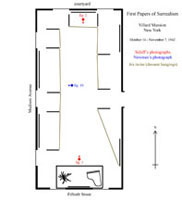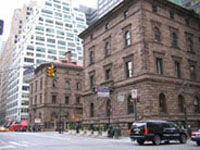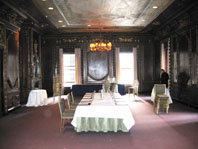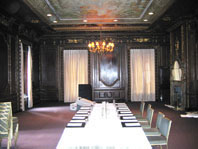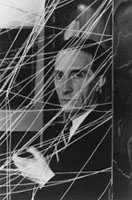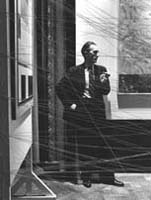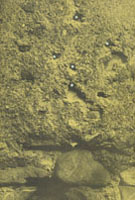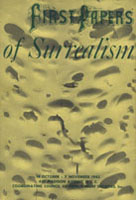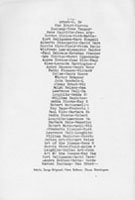The First Papers of Surrealism exhibition, which opened on October 14, 1942 at the Whitelaw Reid Mansion in midtown Manhattan, was both historic and peculiar. As heralded by Newsweek magazine, First Papers of Surrealism was the “biggest all-surrealist show ever seen in the United States.”(1) It announced the arrival of Surrealism’s most celebrated artists, many of whom had recently left Europe to avoid the war. The exhibition’s title, in fact, alluded to the documents some artists had needed during their travels. In addition, First Papers of Surrealism benefited the Coordinating Council of French Relief Societies, a wartime charity organization.(2) In such ways, the show was a very serious event, a product of and a response to the tumultuous political environment of the early 1940s.
click to enlarge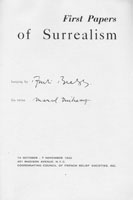
Figure 1
Title page, First Papers
of Surrealism catalogue,
1942. Philadelphia Museum of Art.
But First Papers of Surrealism was an equally whimsical affair, a playful reordering of the gallery experience. At the show’s opening, as children ran around and played catch, several hundred feet of twine, hung by Marcel Duchamp, festooned the primary exhibition space.(3) This installation—hereafter referred to as his twine, the original title given by the First Papers of Surrealism catalogue (Fig. 1)—acted as something of a veil.(4) It partially masked the room’s ornate Gilded Age architecture, as well as some of the paintings on display.(5) Though certainly unorthodox, this installation was not without precedent. At the 1938 Exposition Internationale du Surréalisme in Paris, a taxicab carrying snail-covered mannequins was parked near the gallery’s entrance, coal bags were suspended from the ceilings, and the lights were dimmed so that visitors needed flashlights to see.(6)
In the First Papers of Surrealism exhibition, Duchamp’s twine created an intriguing environment through an economy of means. Yet for all the simplicity of the installation’s material, visitors were left uncertain of his twine‘s significance. As perhaps expected, the installation elicited a variety of interpretations. For Elsa Schiaparelli, one of the exhibition’s coordinators, the twine was something of a guide, “directing visitors to this and that painting with a definite sense of contrast.”(7) Edward Alden Jewell, the New York Times art critic, focused on the installation’s functional effects, reporting that, “[the twine] forever gets between you and the assembled art, and in so doing creates the most paradoxically clarifying barrier imaginable.”(8) Some visitors, such as Harriet and Sidney Janis, on the other hand, opted for more metaphorical interpretations. They believed the installation represented the complexity of understanding contemporary art, writing that Duchamp’s use of twine “symbolized literally the difficulties to be circumvented by the uninitiate in order to see, to perceive and understand, the exhibitions.” (9)
Duchamp himself never provided any explicit interpretation of his twine. Instead, he tended, like Jewell, to stress more his twine’s functional value than its symbolic meaning. He believed that the installation was more transparent than opaque, saying in a 1953 interview: “It was nothing. You can always see through a window, through a curtain, thick or not thick, you can see always through if you want to, same thing there.”(10) In recalling the frustration some of the other participating artists felt for his twine, Duchamp was unsympathetic. He doubted why “Some painters were actually disgusted with the idea of having their paintings back of lines like that, thought nobody would see their paintings.”(11)
That Duchamp was keen to downplay, even deny, the obstructing quality of his twine is especially interesting, because that aspect has been the one most emphasized since First Papers of Surrealism closed on November 7, 1942. The installation has generally been discussed in terms of separation and dislocation; the twine deemed a dividing barrier, or what T.J. Demos calls “the maximal obstacle between paintings and viewing space.”(12) This approach to the exhibition sets into motion a series of conflicts—installation versus paintings, paintings versus viewers, viewers versus installation—and has provided further opportunity to contextualize the exhibition within the political, social, and economic tensions of World War II. As Duchamp’s statements suggest, however, conflict was not the intended product of his twine.
click to enlarge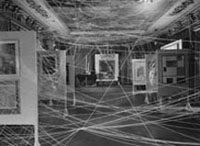
Figure 2
John Schiff, his twine at
First Papers of Surrealism
(South view), 1942. Philadelphia
Museum of Art.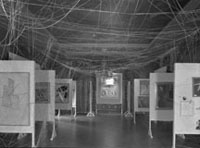
Figure 3
John Schiff, his twine
at First Papers of Surrealism
(North view), 1942.
Philadelphia Museum of Art.
Looking at a photograph of the First Papers of Surrealism installation taken by John Schiff (Fig. 2), it is easy to see why his twine might be interpreted as an obstacle between viewer and art. The twine crisscrosses back and forth across the photograph’s frame, making the gallery and the art on display appear inaccessible. This photograph, moreover, is the best known and most consistently cited record of First Papers of Surrealism, which might explain the prevalence of this interpretation. Photographs, however, can be misleading, and Schiff’s is no exception.(13) Though the photograph suggests a separation between the viewer—in this case Schiff—and the art, Duchamp’s twine installation was more permeable and the art on display more accessible than many believe it to have been. The essay to follow will clarify these misconceptions through a detailed study of the First Papers of Surrealism photographs and of the architecture of the gallery space itself, with the ultimate goal being a more complete and accurate conception of the exhibition’s design.
The aforementioned photograph by Schiff is reproduced, along with another installation shot (Fig. 3), in Lewis Kachur’s book Displaying the Marvelous, the most comprehensive study of First Papers of Surrealism to date.(14) The same two photographs are also reproduced in Robert Lebel’s Marcel Duchamp.(15) These photographs constitute the most comprehensive visual record of the exhibition and of his twine. Combined, they show the gallery in its near-entirety by presenting the room from opposite ends; one photograph looks north, the other south. They do not show the gallery from a single vantage point, nor were they “taken from the center” of the room, as Kachur has described them.(16)
To determine where Schiff’s photographs were taken and what they represent, it is necessary to visualize the architecture of the gallery itself. For the sake of clarity, this essay is accompanied by an interactive floor plan of the space (Fig. 4).(17) Approximately 54 feet long by 25 feet wide, the room sits on the second floor of the Reid Mansion’s southern wing (Fig. 5). On the gallery’s west side, situated directly above Madison Avenue, there are three windows. The north and south ends each have two windows, which overlook the mansion’s courtyard and Fiftieth Street, respectively. Even though the gallery windows were covered during the exhibition, their locations are betrayed by light reflecting off the floor and are thus easily discernable in Schiff’s photographs. These same photographs do not show the gallery’s entrance, which was located at the middle of the east wall. They instead show only the ornate molding around the doorway, the entrance itself being hidden by the temporary partitions set up for the exhibition.
click images to enlarge
- Figure 4
- Figure 5
- First Papers of Surrealism
gallery plan, 1942, Design
by the author, 2006. - New York Palace Hotel (formerly
the Whitelaw Reid Mansion), New York, 2006.
Photograph by the author.
These partitions, each situated perpendicular to the nearest wall, allowed the Surrealists to increase the hanging space. As illustrated in the floor plan, there were ten such partitions: five ran the course of the west wall; two were placed at the north end; and three sat along the east wall. At the south end was a small stage with a piano on it. (Though they did little to change the gallery’s layout, there were also six temporary partitions set parallel to and directly against the walls, presumably used to avoid putting holes in the room’s original wood paneling.) On the whole, his twine was restricted to the ceiling space and the gaps between neighboring partitions—the main exception to this rule being the space between the two partitions flanking the entrance. There, a lack of twine allowed visitors to enter. The interior of the gallery was also free of twine and thus open to ambulation. Carroll Janis, the son of Harriet and Sidney Janis and one of the children present at the First Papers of Surrealism opening, confirms these details, recalling that “there was free access down the center of the large room, with ‘partitioned niches’ on either side.”(18)
A close examination of Schiff’s photographs makes it is possible to recreate where he stood when shooting. These vantages, which are marked on the accompanying floor plan, have also been recreated in two included photographs (Figs. 6-7).(19) Because the view of the room’s southern end shows the stage that was set up there, the view of the northern end must have been taken from somewhere in the vicinity of this platform. Duchamp used hardly any twine in that area, so the photograph taken from the south (the north view) is without foreground obstructions. This photograph in turn shows that its counterpart, the south view, was taken from between the partitions at the opposite end of the room. As twine was strung across these partitions, the photograph taken there (the south view) represents the gallery as an area closed-off by a web of intersecting lines. The photograph is therefore deceptive, as the space beyond the twine was actually open and easily accessible.
click images to enlarge
- Figure 6
- Figure 7
- L’Orangerie room at the
New York Palace Hotel (South view),
2006. Photograph by the author. - L’Orangerie room at the New York
Palace Hotel (North view), 2006.
Photograph by the author.
In addition to providing information regarding the layout of First Papers of Surrealism, these photographs highlight the artificiality, or perhaps theatricality, of Schiff’s process. Kachur has described the photographs as being “as straightforward as possible,” but while that claim might hold true for the north view, it is hardly the case with the south.(20) Because of the twine’s layout, photographing the north view would have required little more than standing near or atop the stage. Photographing the south view, however, would have entailed a more involved process. To get this shot, Schiff had to stand behind the twine running between the northernmost partitions. If Duchamp’s installation was indeed a physical barrier, then Schiff’s task would have been quite demanding. But regardless of how easy or difficult the twine was to circumvent, the photographs are nonetheless carefully orchestrated.
Specifically, Schiff’s photographs and the means by which they were taken emphasize and demonstrate the permeability of Duchamp’s installation at First Papers of Surrealism. Even the south view, the one mostly obscured by his twine, nonetheless provides a relatively clear view of the exhibition. Moreover, the photographs actually seem to encourage the practice of looking through his twine. They ask the viewer to acknowledge the installation, the gallery space, and art beyond. It is something of a looking game: focus on the twine; focus on the gallery; focus on the art. The game repeats as the viewer continues through the exhibition. Becoming more accustomed to the environment, the viewer may realize that the relationship between the three entities is more a fluid partnership than a one-sided competition. Schiff’s photographs suggest this sort of dynamic interaction with the twine; in their staging, they actually document that experience.
click to enlarge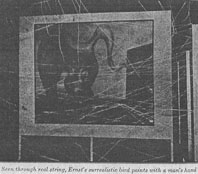
Figure 8
Max Ernst’s Le Surrealism
et la Peinture behind
twine at First Papers of Surrealism
, 1942. Newsweek,
26 October 1942.
Throughout the rest of the First Papers of Surrealism records and materials, the concept of seeing through his twine, of allowing Duchamp’s installation to somehow mediate the viewing experience, is consistently reiterated. A photograph from Newsweek (Fig. 8), for instance, shows Max Ernst’s Le Surréalisme et la Peinture (1942) behind his twine. In this case, the photograph’s small field of view limits the ability to locate either the camera’s vantage point or the placement of Ernst’s painting (though the work does appear to hang on one of the six partitions set parallel to and directly against the gallery walls). More importantly, the Newsweek photograph demonstrates how easily one could have viewed the painting despite the presence of the twine. Arnold Newman, another photographer to take pictures of the First Papers of Surrealism installation, took at least two photographs of his twine, both of which include Duchamp. In one (Fig. 9), the artist looks out coyly from behind his twine; in the other (Fig. 10), he stands beside his 1913 Cimetière des Uniformes et Livrées (or Network of Stoppages, as it is known in English). In both photographs, his twine functions as a framing device, something to be recognized but not focused upon.
click images to enlarge
- Figure 9
- Figure 10
- Arnold Newman, Marcel Duchamp, 1942. Philadelphia Museum of Art.
- Arnold Newman, Marcel Duchamp behind his installation of “sixteen miles of string,” 1942. Zabriskie Gallery website.
click to enlarge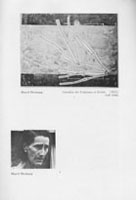
Figure 11
Marcel Duchamp,” First Papers of
Surrealism catalogue, 1942.
Philadelphia Museum of Art.
Since the geometric painting to Duchamp’s right in the second photograph by Newnam also appears in Schiff’s south view, Cimetière des Uniformes et Livrées must have hung on the partition between the middle and northernmost windows of the west wall of the gallery. The vantage point of Newman’s photograph, in turn, would have been just north of the gallery’s center.(21) This point is also marked on the included floor plan. That Duchamp was posed beside this particular painting is not a coincidence. Cimetière des Uniformes et Livrées, which was fully reproduced in the exhibition catalogue (Fig. 11), is a layering of imagery derived from other paintings and drawings, the top level being the synapse-like forms of 3 Standard Stoppages (1914), made by dropping meter-long threads from a height of one meter onto a horizontal surface.(22) In other words, Newman’s photograph shows a painting behind twine of a painting behind twine. A more reflexive image could hardly be imagined.
Duchamp may well have collaborated with Newman on setting up the photograph. Duchamp’s designs for the First Papers of Surrealism catalogue emphasize permeability and the process of looking through. On the front cover is an image of a wall pocked with bullet holes through which Duchamp punched five actual holes (Fig. 12), while on the page facing Sidney Janis’s foreword to the catalogue, the artists participating in the exhibition are listed so that their names collectively create the shape of a keyhole (Fig. 13), again referencing the process of looking through.(23) The back cover is a detailed image of Swiss cheese (Fig. 14).(24) By emphasizing the transparency of his twine, Newman’s photographs reiterate the iconography of the catalogue. If Duchamp did not actively collaborate with Newman in creating the compositions of the photographs, they are nonetheless very much in keeping with the central idea of the First Papers of Surrealism installation and catalogue.
click images to enlarge
- Figure 12
- Figure 13
- Figure 14
- Front Cover, First Papers
of Surrealism catalogue, 1942.
Philadelphia Museum of Art. - Artists names in keyhole,
First Papers of Surrealism catalogue,
1942. Philadelphia Museum of Art. - Back Cover, First Papers
of Surrealism catalogue,
1942. Philadelphia Museum of Art.
The Newman photograph of Duchamp beside Cimetière des Uniformes et Livrées also shows that twine was strung only from the edges of each partition on the sides closest to the middle of the gallery. Each partition, moreover, was set not directly against the wall but out by two or three feet. Such a layout would have made possible a navigable corridor ringing parts of the gallery’s east, north, and west walls. The corridor would have allowed passage around the gallery’s perimeter and entrance into the niches between facing partitions. The existence of such channels, however, is somewhat speculative. When asked, Carroll Janis could not confirm their presence, but nor could he deny the possibility that they had been there, writing, “I do not recall any corridor running around the back of the niches – but I wasn’t looking for it either!”(25)
If there was not a continuous walkway, some other means of passage through his twine must have been present. How else could Schiff’s and Newman’s photographs be explained? Janis claims to “[not] recall any real access into the niches,” though he counters that, “the string had a certain fragile character…one could have slipped under at certain points.”(26) Jewell, whose account may be more reliable given his age at the time and the nature of his job, provides a more convincing description. He reports that “intrepid” visitors could “reach closer proximity [to the paintings] by means of certain strategically placed apertures.”(27) This statement, beyond verifying the existence of openings in his twine, indicates that such “apertures” were intentionally created for the express purpose of accessing the partitioned niches. In Schiff’s north view of First Papers of Surrealism, such an opening appears to exist between the partitions perpendicular to one another at the gallery’s northwest corner. Close to the gallery’s north end and to the spot where Cimetière des Uniformes et Livrées hung, this opening was likely the one used by Schiff when he shot his south view of the exhibition and by Duchamp when he posed for Newman.
Just how many people actually chose to traverse the skeins of the First Papers of Surrealism installation is uncertain. Duchamp and Schiff count for at least two, and perhaps there were more. But even if only a few visitors were “intrepid” enough to pass through the installation, the possibility for such passage is a reminder that his twine was far less an impediment than commonly believed. Moreover, for those who did not physically navigate the installation, his twine arguably did more to enhance the paintings on display than it did to obscure them. “It was,” as Janis writes, “a fantastically interesting see-through construction, which transformed the gallery space into an unforgettable experience.” Contrary to his parents’ interpretation, Janis believes the twine actually “helped explicate the new art.”(28)
click to enlarge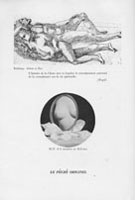
Figure 15
First Papers of Surrealism
catalogue, 1942. Philadelphia
Museum of Art.
That Duchamp’s installation at the First Papers of Surrealism exhibition would be concerned with new, intriguing, and even playful methods of looking at art is not surprising. Experimenting with sight was for Duchamp a lifelong preoccupation. A work like To Be Looked at (from the Other Side of the Glass), with One Eye, Close to, for Almost an Hour (1918) predates the exhibition and demonstrates an early example of how Duchamp chose to engage the practice of looking. Concurrent with First Papers of Surrealism—and less than nine blocks away—at Peggy Guggenheim’s Art of This Century gallery, Duchamp’s Boîte-en-valise (1935-41) was on display through the peephole of a web-like apparatus.(29) Some years later, Duchamp would begin work on Etant donnés: 1° la chute d’eau, 2° le gaz d’éclairage (1946-66), a piece that summarizes many of the artist’s diverse interests but is above all about the act of looking through. Since the First Papers of Surrealism catalogue includes a reproduction of Duchamp’s In the Manner of Delvaux (1942) (Fig. 15), a collage showing a fragmented view of a female nude, Etant donnés, may have already been on Duchamp’s mind.(30) The use of certain other imagery in the catalogue—bullet holes, Swiss cheese, a keyhole—only furthers the likelihood of that possibility.
To what extent Duchamp himself would have related these or other works to the First Papers of Surrealism installation is uncertain. From a material point of view, he may have considered his twine to be more akin to 3 Standard Stoppages or With Hidden Noise (1916), as both those works involve string. Compositionally, he may have found more in common with Sculpture for Traveling (1918), another temporary work, which involved stretching parts of a bathing cap to different walls of a room. In truth, different aspects of his twine might resonate equally with many different works by Duchamp, and likewise there may be many ways to interpret the installation beyond the artist’s oeuvre alone. But analysis of that variety has never been this essay’s goal. The primary concern has always been the reexamination of the First Papers of Surrealism texts, photographs, and space. As his twine no longer hangs, having existed for not even a month, this documentary material is of utmost importance. By synthesizing as much of this information as possible, the hope has been the achievement of a more concrete understanding of the exhibition’s design and of the role his twine played there.
 1. “Agonized Humor,” Newsweek, 26 Oct 1942, 76.
1. “Agonized Humor,” Newsweek, 26 Oct 1942, 76.
 2. Ticket prices were listed as $1.10 for the opening preview and $.50 thereafter, as noted by Edward Alden Jewell in “Surrealists Open Display Tonight,” New York Times, 14 Oct 1942, from ProQuest Historical Newspapers the New York Times (1851-2003) .
2. Ticket prices were listed as $1.10 for the opening preview and $.50 thereafter, as noted by Edward Alden Jewell in “Surrealists Open Display Tonight,” New York Times, 14 Oct 1942, from ProQuest Historical Newspapers the New York Times (1851-2003) .
 3. At the request of Duchamp, Carroll Janis, the son of Sidney and Harriet Janis, and friends ran around and played ball in the galleries. The performance tickled some of the adult visitors and frustrated others. In Lewis Kachur’s Displaying the Marvelous (Cambridge: MIT Press, 2001), Kachur explains the children’s activities in a section called “Vernissage Consacré aux Enfants Jouant, à l’Odeur du Cèdre,” 195-7.
3. At the request of Duchamp, Carroll Janis, the son of Sidney and Harriet Janis, and friends ran around and played ball in the galleries. The performance tickled some of the adult visitors and frustrated others. In Lewis Kachur’s Displaying the Marvelous (Cambridge: MIT Press, 2001), Kachur explains the children’s activities in a section called “Vernissage Consacré aux Enfants Jouant, à l’Odeur du Cèdre,” 195-7.
 4. André Breton and Marcel Duchamp, First Papers of Surrealism (New York: Coordinating Council of French Relief Societies, Inc., 1942). As news of the installation spread, Duchamp’s handiwork soon acquired the catchy name Sixteen Miles of String. See, for instance, Robert Coates, “The Art Galleries, Sixteen Miles of String,” New Yorker, October 31, 1942, 72; Alfred M. Frankfurter, “The Passing Shows,” Art News: November 1-14, 1942, 24. This moniker, however, is misleading, as no such length was ever used; moreover, it is unnecessary when compared to the simpler title originally given in the exhibition catalogue: “his twine.” This phrase appears on the catalogue’s title page, alongside other basic information regarding the show. The same page also credits the “hanging” to André Breton, who indeed helped coordinate the exhibition. Thus, although “his twine” may also be understood as wordplay on “his twin,” a reference to the friendship between Duchamp and Breton, that interpretation is certainly secondary to the phrase’s purpose as a title credit.
4. André Breton and Marcel Duchamp, First Papers of Surrealism (New York: Coordinating Council of French Relief Societies, Inc., 1942). As news of the installation spread, Duchamp’s handiwork soon acquired the catchy name Sixteen Miles of String. See, for instance, Robert Coates, “The Art Galleries, Sixteen Miles of String,” New Yorker, October 31, 1942, 72; Alfred M. Frankfurter, “The Passing Shows,” Art News: November 1-14, 1942, 24. This moniker, however, is misleading, as no such length was ever used; moreover, it is unnecessary when compared to the simpler title originally given in the exhibition catalogue: “his twine.” This phrase appears on the catalogue’s title page, alongside other basic information regarding the show. The same page also credits the “hanging” to André Breton, who indeed helped coordinate the exhibition. Thus, although “his twine” may also be understood as wordplay on “his twin,” a reference to the friendship between Duchamp and Breton, that interpretation is certainly secondary to the phrase’s purpose as a title credit.
 5. Built in 1884 by McKim, Mead & White, the mansion was originally intended for railroad tycoon Henry Villard. Bankruptcy forced Villard to give up possession of the property, selling it to Whitelaw Reid, then editor of the New York Tribune. Today, the estate is part of the New York Palace Hotel, which calls the wing where the 1942 exhibition was held the Villard Mansion. See Christopher Gray, “Streetscape/Madison Avenue Between 50th and 51st Street; A Landmark 6-Home Complex in Dark Brownstone,” New York Times, 21 Dec 2003, from ProQuest Historical Newspapers the New York Times (1851-2003).
5. Built in 1884 by McKim, Mead & White, the mansion was originally intended for railroad tycoon Henry Villard. Bankruptcy forced Villard to give up possession of the property, selling it to Whitelaw Reid, then editor of the New York Tribune. Today, the estate is part of the New York Palace Hotel, which calls the wing where the 1942 exhibition was held the Villard Mansion. See Christopher Gray, “Streetscape/Madison Avenue Between 50th and 51st Street; A Landmark 6-Home Complex in Dark Brownstone,” New York Times, 21 Dec 2003, from ProQuest Historical Newspapers the New York Times (1851-2003).
 6. This exhibition is addressed in Kachur’s Displaying the Marvelous and Alyce Mahon’s Surrealism and the Politics of Eros, 1938-1968 (London: Thames and Hudson, 2005), among others.
6. This exhibition is addressed in Kachur’s Displaying the Marvelous and Alyce Mahon’s Surrealism and the Politics of Eros, 1938-1968 (London: Thames and Hudson, 2005), among others.
 8. Edward Alden Jewell, “‘Inner Vision’ and Out of Bounds,” New York Times, 18 Oct 1942, from ProQuest Historical Newspapers the New York Times (1851-2003).
8. Edward Alden Jewell, “‘Inner Vision’ and Out of Bounds,” New York Times, 18 Oct 1942, from ProQuest Historical Newspapers the New York Times (1851-2003).
 9. Harriet and Sidney Janis, “Marcel Duchamp, Anti-Artist,” View 5, no. 1 (March 1945), 18. Arturo Schwarz makes a similar interpretation in his The Complete Works of Marcel Duchamp (New York: Harry N. Abrams, 1969), 515.
9. Harriet and Sidney Janis, “Marcel Duchamp, Anti-Artist,” View 5, no. 1 (March 1945), 18. Arturo Schwarz makes a similar interpretation in his The Complete Works of Marcel Duchamp (New York: Harry N. Abrams, 1969), 515.
 10. Duchamp quoted in Kachur, 183
10. Duchamp quoted in Kachur, 183
 12. T. J. Demos, “Duchamp’s Labyrinth: First Papers of Surrealism, 1942,” October (Summer 2001), 94.
12. T. J. Demos, “Duchamp’s Labyrinth: First Papers of Surrealism, 1942,” October (Summer 2001), 94.
 13. Interestingly, the reception of his twine is strikingly similar to that of Duchamp’s Fountain, 1917. In both cases, photographs have been the primary means for seeing the original work. That is of course true with his twine, a temporary installation seen only by gallery visitors. Fountain also no longer exists, although replicas are on display at several museums, in particular the Philadelphia Museum of Art. Even before the original was lost, however, Fountain was for years known largely through Alfred Stieglitz’s 1917 photograph of the work. Stieglitz’s photograph exaggerated the formal qualities of Fountain, prompting critics to respond with overly aesthetical interpretations of the readymade. Yet time has shown that Fountain is more an ironic and provocative critique of art than an objet d’art per se. As this study explains, Schiff’s photograph of his twine suggests a more imposing, impassible installation than in reality. For more on the reception of Fountain, see William Camfield, Marcel Duchamp: “Fountain” (Houston: Menil Foundation, 1989), particularly pages 13-60.
13. Interestingly, the reception of his twine is strikingly similar to that of Duchamp’s Fountain, 1917. In both cases, photographs have been the primary means for seeing the original work. That is of course true with his twine, a temporary installation seen only by gallery visitors. Fountain also no longer exists, although replicas are on display at several museums, in particular the Philadelphia Museum of Art. Even before the original was lost, however, Fountain was for years known largely through Alfred Stieglitz’s 1917 photograph of the work. Stieglitz’s photograph exaggerated the formal qualities of Fountain, prompting critics to respond with overly aesthetical interpretations of the readymade. Yet time has shown that Fountain is more an ironic and provocative critique of art than an objet d’art per se. As this study explains, Schiff’s photograph of his twine suggests a more imposing, impassible installation than in reality. For more on the reception of Fountain, see William Camfield, Marcel Duchamp: “Fountain” (Houston: Menil Foundation, 1989), particularly pages 13-60.
 14. Kachur, 176, fig. 4.3; 180, fig. 4.5.
14. Kachur, 176, fig. 4.3; 180, fig. 4.5.
 15. Robert Lebel, Marcel Duchamp (New York: Grove Press, Inc., 1959), plates 111a and 111b.
15. Robert Lebel, Marcel Duchamp (New York: Grove Press, Inc., 1959), plates 111a and 111b.
 17. The floor plan was drafted by the author according to measurements taken at the gallery. The placement of the partitions and the stage have been determined as best as possible according to the photographs by Schiff and Newman.
17. The floor plan was drafted by the author according to measurements taken at the gallery. The placement of the partitions and the stage have been determined as best as possible according to the photographs by Schiff and Newman.
 18. Carroll Janis, letter to the author, 31 January 2007.
18. Carroll Janis, letter to the author, 31 January 2007.
 19. The gallery, part of the New York Palace Hotel (see note 5), is now called L’Orangerie and is a meeting/banquet hall. I visited the L’Orangerie room on November 7, 2006, coincidentally the sixty-fourth anniversary of the First Papers of Surrealism closing. Despite some renovations to the ceiling and the installation of some modern fixtures, the room seems to have changed little since 1942. At the New York Palace Hotel, I took a series of digital photographs and videos to document my visit. In particular, I tried to recreate the photographs taken by Schiff and Newman, which have been included here along with an exterior shot of the mansion.
19. The gallery, part of the New York Palace Hotel (see note 5), is now called L’Orangerie and is a meeting/banquet hall. I visited the L’Orangerie room on November 7, 2006, coincidentally the sixty-fourth anniversary of the First Papers of Surrealism closing. Despite some renovations to the ceiling and the installation of some modern fixtures, the room seems to have changed little since 1942. At the New York Palace Hotel, I took a series of digital photographs and videos to document my visit. In particular, I tried to recreate the photographs taken by Schiff and Newman, which have been included here along with an exterior shot of the mansion.
 21. Ibid., 176, image caption 4.3, indicates this work as one by Robert Motherwell. It is not, however, El Miedo de la Obscuridad (1942), the Motherwell work reproduced in the First Papers of Surrealism catalogue. That it is even by Motherwell seems questionable. Kachur also identifies in this photograph works by Paul Klee, Ernst, Marc Chagall, Alexander Calder, and Pablo Picasso. In the other photograph by Schiff, reproduced on page 176, Kachur identifies works by Picasso, Yves Tanguy, René Magritte, Giorgio de Chirico, and Jean Arp.
21. Ibid., 176, image caption 4.3, indicates this work as one by Robert Motherwell. It is not, however, El Miedo de la Obscuridad (1942), the Motherwell work reproduced in the First Papers of Surrealism catalogue. That it is even by Motherwell seems questionable. Kachur also identifies in this photograph works by Paul Klee, Ernst, Marc Chagall, Alexander Calder, and Pablo Picasso. In the other photograph by Schiff, reproduced on page 176, Kachur identifies works by Picasso, Yves Tanguy, René Magritte, Giorgio de Chirico, and Jean Arp.
 22. For an animated illustration of how the works combine into a single whole, see Greg Alvarez’s video at http://www.marcelduchamp.net/stoppages.php.
22. For an animated illustration of how the works combine into a single whole, see Greg Alvarez’s video at http://www.marcelduchamp.net/stoppages.php.
 23. It was actually Duchamp himself who fired a gun at the wall. See Martica Sawin, Surrealism in Exile and the Beginning of the New York School (Cambridge: MIT Press, 1995), 222-6.
23. It was actually Duchamp himself who fired a gun at the wall. See Martica Sawin, Surrealism in Exile and the Beginning of the New York School (Cambridge: MIT Press, 1995), 222-6.
 24. A debate has arisen regarding this cheese, particularly what exact type is shown. See Stephen E. Hauser, “Marcel Duchamp Chose Emmentaler Cheese (1942),” Tout-Fait: The Marcel Duchamp Studies Online Journal, Issue 3, 2003 (27 November 2006).
24. A debate has arisen regarding this cheese, particularly what exact type is shown. See Stephen E. Hauser, “Marcel Duchamp Chose Emmentaler Cheese (1942),” Tout-Fait: The Marcel Duchamp Studies Online Journal, Issue 3, 2003 (27 November 2006).
 27. “Surrealists Open Display Tonight.”
27. “Surrealists Open Display Tonight.”
 30. Thomas Singer claims in “In the Manner of Duchamp, 1942-47: The Years of the ‘Mirrorical Return,’” Art Bulletin 86, no. 2 (June 2004) 346-69 that the origins of Etant donnés can be traced to In the Manner of Delvaux. His analysis, however, does not closely consider the work’s reproduction in the First Papers of Surrealism catalogue. Furthermore, while the conclusion drawn by Singer is correct—that the collage relates to Etant donnés—his argument is confusing. His study overemphasizes the importance of infrathinness, forgery, and mirrors, but does not discuss the striking visual similarities between a peephole and the cropping of In the Manner of Delvaux as it is reproduced.
30. Thomas Singer claims in “In the Manner of Duchamp, 1942-47: The Years of the ‘Mirrorical Return,’” Art Bulletin 86, no. 2 (June 2004) 346-69 that the origins of Etant donnés can be traced to In the Manner of Delvaux. His analysis, however, does not closely consider the work’s reproduction in the First Papers of Surrealism catalogue. Furthermore, while the conclusion drawn by Singer is correct—that the collage relates to Etant donnés—his argument is confusing. His study overemphasizes the importance of infrathinness, forgery, and mirrors, but does not discuss the striking visual similarities between a peephole and the cropping of In the Manner of Delvaux as it is reproduced.



